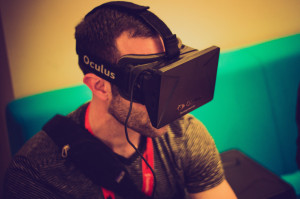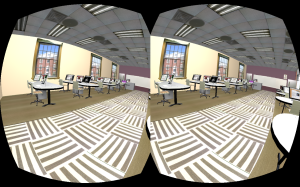Tech Spotlight: Dr. Crider and the Oculus Rift
 Dr. Tony Crider, Associate Professor of Physics, is pushing the boundaries of the virtual world with his Oculus Rift, a virtual reality headset. I met with him to find out the details, namely how this piece of technology could be used in education and its application to a variety of disciplines. But first, he let me try it on for a few minutes.
Dr. Tony Crider, Associate Professor of Physics, is pushing the boundaries of the virtual world with his Oculus Rift, a virtual reality headset. I met with him to find out the details, namely how this piece of technology could be used in education and its application to a variety of disciplines. But first, he let me try it on for a few minutes.
The Oculus Rift is like a large pair of goggles that straps onto your head. Dr. Crider selected what I saw within the headset from his computer. First, I was able to go on a virtual roller coaster ride, complete with a boulder chasing me from behind. Then, I went inside a simulation of Jerry Seinfeld’s apartment.
I was only able to test drive the Rift for a few minutes, though, before getting nauseous. “That’s because of the lag time,” Dr. Crider explained. There is a slight delay within the virtual world when you move your head, and that is what signals to your brain that something isn’t right, thus causing the nausea.
After a few minutes of play, we settled down to discuss what the implications of this kind of technology really are.
When did you get the Oculus Rift?
Dr. Crider received this prototype about six months ago, but a new one is already available. The newer prototype has made certain advancements that will decrease the lag issue I experienced. “Right now,” Dr. Crider explained, picking up the Rift, “this is like your iPhone. If you tilt it, it knows which way it’s tilting, but it doesn’t know where it is in space.” The new version has dots on the outside, as well as an external camera that will enable the device to calculate where it is in space.
Dr. Crider emphasized that the Rift he has is a “Developer Kit.” It isn’t intended for use by the masses, but more so for individuals like him, interested in it for research purposes. Dr. Crider says that he will not get the latest model, but will likely get the next one, as there will be even more improvement.
How are you using this with your students?

Stereo images of the second floor lab in Powell created by Dr. Crider’s Virtual Environment students.
Dr. Crider does not have enough of the headsets to successfully use in the classroom, and again, the prototype isn’t quite ready to be used in this setting yet. However, he has had students create 3D content that can be viewed with the Oculus Rift.
In the past, Dr. Crider used a program called Second Life to develop the 3D worlds. He used to have students in his Intro to Astronomy class do it, but now reserves it for his graduate classes in the iMedia program. Now, they use a program called OpenSim. He showed me some examples of their work on his computer–a house where the appliances glow green, based on their greenhouse gas emission, a coral reef in which coral is dying because temperatures are rising, and a planetarium.
“Now,” Dr. Crider said, “we can actually put the Oculus Rift on and go inside all of that.” Before, the headset didn’t exist, but his students were creating content for it. This was difficult because some students couldn’t adjust to the notion of the avatar, the 3D person representing them in the virtual world. “But this throws that away. You don’t need that anymore. You’re seeing what that character sees,” he said.
Six of his former students also built the entire second floor of Powell building, and a current iMedia class taught by Kenn Gaither will “attend” a virtual class in the classroom that they created. Dr. Crider says that it took them a couple of weeks to build the entire floor, computer labs and all. With OpenSim, the students are able to build good quality content quickly, which is ideal for the structure of the class. “We would spend Tuesdays reading about the theory of design, and Thursdays actually developing.”
What is the educational potential for the Oculus Rift?
Aside from being able to explore the virtual content his students create, Dr. Crider feels that the headset’s greatest asset will be its ability to “convey a sense of size, scale, and place” in the classroom. With the Oculus Rift, educators can have students experience, say, The Great Wall of China, within the virtual world. “You can show a picture of a giant radio telescope and say, here’s how it looks compared to the Statue of Liberty. But to actually put on a headset and say, here it is–you don’t need any semantics or visual cues, you just tilt your head back to look up at it.”
Dr. Crider thinks that it will take awhile before people become comfortable with this kind of technology. Still, it will be groundbreaking in a wide scope of disciplines–from designing a building, to storytelling–and especially in experiencing a specific place…like the moon.
“NASA’s talking about using this for exploring data sets, as well.” People may not be able to physically go to Mars, but this kind of technology will enable them to experience it. “They can take real data captured by the robots, map it out onto an artificial terrain, and let people explore it in a natural way, rather than trying to use cursors and zooming in and out of it,” Dr. Crider explained.
“It’s a lot closer than you think,” he said, of the possibility to do such a thing like go for a walk on Mars or the moon while standing on Earth. “This will be the next interface jump, where you’re immersed in your environment, rather than looking at it.”
 Follow
Follow